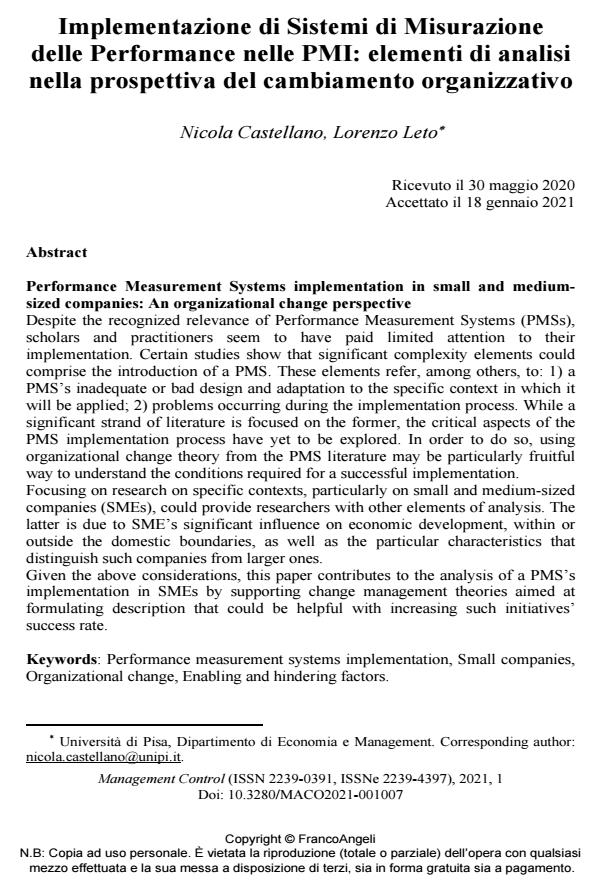Performance Measurement Systems implementation in small and mediumsized companies: An organizational change perspective
Journal title MANAGEMENT CONTROL
Author/s Nicola Castellano, Lorenzo Leto
Publishing Year 2021 Issue 2021/1
Language Italian Pages 22 P. 129-150 File size 257 KB
DOI 10.3280/MACO2021-001007
DOI is like a bar code for intellectual property: to have more infomation
click here
Below, you can see the article first page
If you want to buy this article in PDF format, you can do it, following the instructions to buy download credits

FrancoAngeli is member of Publishers International Linking Association, Inc (PILA), a not-for-profit association which run the CrossRef service enabling links to and from online scholarly content.
Despite the recognized relevance of Performance Measurement Systems (PMSs), scholars and practitioners seem to have paid limited attention to their implementation. Certain studies show that significant complexity elements could comprise the introduction of a PMS. These elements refer, among others, to: 1) a PMS’s inadequate or bad design and adaptation to the specific context in which it will be applied; 2) problems occurring during the implementation process. While a significant strand of literature is focused on the former, the critical aspects of the PMS implementation process have yet to be explored. In order to do so, using organizational change theory from the PMS literature may be particularly fruitful way to understand the conditions required for a successful implementation. Focusing on research on specific contexts, particularly on small and medium-sized companies (SMEs), could provide researchers with other elements of analysis. The latter is due to SME’s significant influence on economic development, within or outside the domestic boundaries, as well as the particular characteristics that distinguish such companies from larger ones. Given the above considerations, this paper contributes to the analysis of a PMS’s implementation in SMEs by supporting change management theories aimed at formulating description that could be helpful with increasing such initiatives’ success rate.
Keywords: Performance measurement systems implementation, Small companies, Organizational change, Enabling and hindering factors
- Value-based Management System e performance. Il ruolo di moderazione della strategia ibrida e della turbolenza ambientale Filippo Zanin, Giulio Corazza, in MANAGEMENT CONTROL 3/2024 pp.63
DOI: 10.3280/MACO2023-003004 - Creatività organizzativa ed individuale nelle piccole e medie imprese: il ruolo del sistema di controllo Daniela Di Berardino, Faisal Anees, in MANAGEMENT CONTROL 1/2024 pp.227
DOI: 10.3280/MACO2024-001011 - Integrating Change Management and Management Accounting Change Lorenzo Leto, pp.57 (ISBN:978-3-031-84386-0)
- Integrating Change Management and Management Accounting Change Lorenzo Leto, pp.1 (ISBN:978-3-031-84386-0)
- Metaverse: Value creation and performance measurement across physical and digital world Rosita Capurro, Raffaele Fiorentino, Stefano Garzella, Stefano Marciano, in MANAGEMENT CONTROL 1/2024 pp.131
DOI: 10.3280/MACO2024-001007
Nicola Castellano, Lorenzo Leto, Implementazione di Sistemi di Misurazione delle Performance nelle PMI: elementi di analisi nella prospettiva del cambiamento organizzativo in "MANAGEMENT CONTROL" 1/2021, pp 129-150, DOI: 10.3280/MACO2021-001007